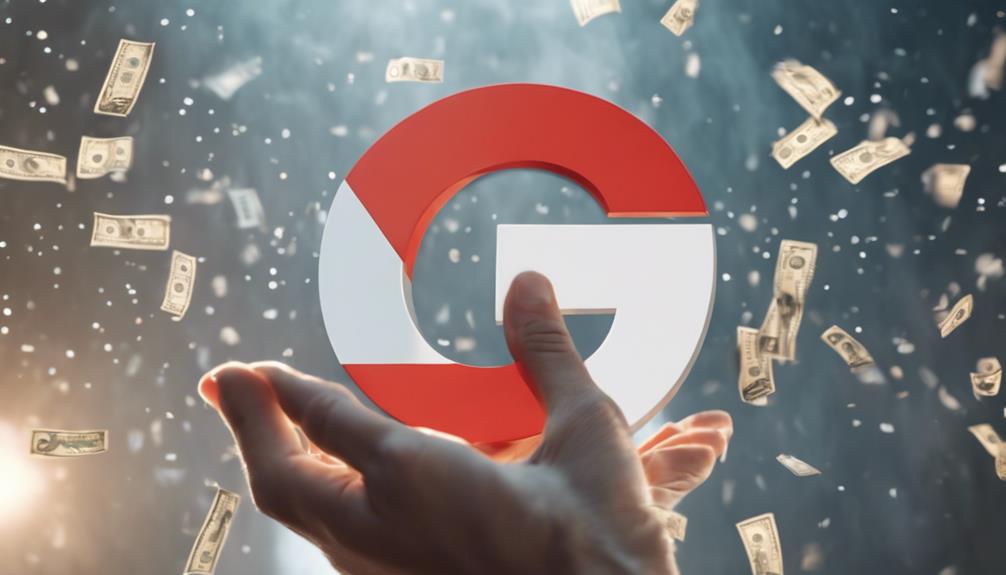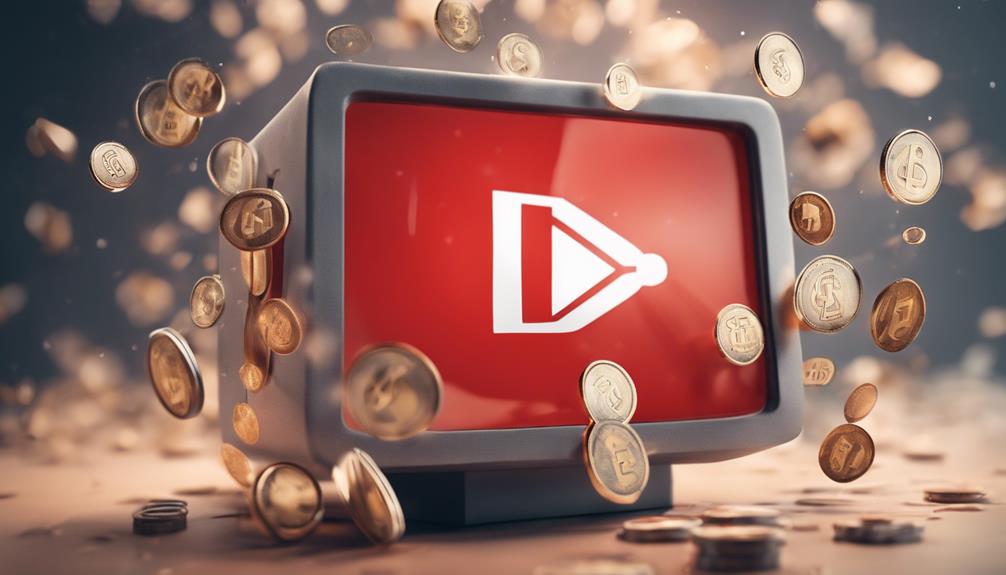
How much is YouTube tube?
Navigating the ocean of digital media, you’ve likely pondered the worth of the colossal ship that is YouTube. The platform has grown incredibly since its inception in 2005, becoming a cornerstone of modern digital culture.
But what’s the actual dollar value of YouTube, and what economic engines drive it? How did Google’s acquisition alter its trajectory, and what might the future hold? It’s a fascinating journey to explore, full of surprising twists and turns.
Let’s embark on this exploration together, and you might just be surprised by what we uncover.
Key Takeaways
- YouTube’s market value is intricately tied to Google’s worth, making its true value complex to determine.
- Google’s acquisition and monetization methods have greatly influenced YouTube’s financial implications.
- Diversification through YouTube Premium and YouTube TV have boosted YouTube’s revenues and increased its market value.
- YouTube’s value is also influenced by its impact on online video, content regulation, and its philanthropic initiatives.
The Founding of YouTube

Let’s dive into the fascinating journey of YouTube’s inception, which took place in 2005 when three former PayPal employees decided to create a platform for sharing videos. The founders’ motivations were fueled by the need for a user-friendly space where people could easily upload, share, and view videos. Jawed Karim, Steve Chen, and Chad Hurley recognized the potential in a technology-driven, interconnected world. They envisioned YouTube as a hub for creativity, communication, and information exchange.
The launch, however, wasn’t without controversy. The first ever YouTube video, entitled ‘Me at the Zoo’, was a far cry from the polished, professional content we associate with the platform today. Some critics doubted the viability of the platform, questioning its sustainability and long-term potential. They couldn’t imagine how a site hosting amateur videos could compete in a market dominated by professional media corporations.
But the founders were undeterred. They believed in their innovative idea, that user-generated content held untapped potential. This faith in innovation, along with their dedication to turning vision into reality, laid the foundation for what YouTube is today: a game-changer in the world of online media.
YouTube’s Initial Funding
You might wonder about the financial backing that got YouTube off the ground.
It’s pertinent to understand the specifics of the seed funding, as well as the key investors who believed in this venture.
This intricate financial puzzle is crucial to appreciate the growth trajectory of YouTube.
Seed Funding Details
In its early stages, YouTube secured an impressive seed funding, a critical step that helped propel the platform’s growth and success. This is a clear example of entrepreneurship lessons learned and how to overcome startup challenges.
To further understand YouTube’s initial success, let’s break down the key aspects of its seed funding:
- The amount raised: It’s not just about the size of the funding but how efficiently it’s used.
- The use of funds: Allocating resources strategically can be a game-changer for startups.
- The timing: Securing funding at the right time can help overcome critical startup challenges.
Investors Behind YouTube
Diving into the roster of initial investors behind YouTube provides a revealing glimpse into the platform’s early financial support and strategic partnerships. This diverse investor demographics indicates a mix of individuals and entities, each wagering on YouTube’s potential success.
| Investor | Investment Type |
|---|---|
| Sequoia Capital | Venture Capital |
| Artist Capital Management | Venture Capital |
| Jawed Karim | Individual (Co-founder) |
| Chad Hurley & Steve Chen | Individual (Co-founders) |
Risks assessment was clearly a significant part of their investment decisions. They saw the inherent innovation and potential for growth in the platform, despite the uncertainties that come with supporting a startup. Their calculated risks indeed paid off, transforming YouTube into a global powerhouse and proving that innovation can indeed lead to unprecedented success.
Google’s Acquisition of YouTube

Let’s consider the historical context of Google’s acquisition of YouTube.
You should take into account the financial implications for Google, not only in terms of the purchase price but also the subsequent investment required.
Also, it’s crucial to examine how this acquisition has transformed the landscape of online video content.
Historical Overview of Acquisition
Have you ever wondered how Google’s acquisition of YouTube unfolded in the historical context? Let’s delve into the details.
The Acquisition Controversy arose when Google agreed to purchase YouTube for $1.65 billion in stock in November 2006. Skeptics questioned the high price tag for a platform that was less than two years old and had yet to turn a profit.
Post Acquisition Changes included:
- The introduction of ads, which turned YouTube into a profitable business.
- The implementation of strict copyright laws to mitigate legal issues.
- The enhancement of video quality and user interface over time.
These changes transformed YouTube into the world’s largest video sharing platform, showcasing Google’s innovative approach to integrating acquisitions.
Financial Implications for Google
Now, consider the financial implications for Google, following their acquisition of YouTube. Google’s stock performance saw a significant rise post-acquisition. But it wasn’t all smooth sailing.
Ad blocking consequences posed a considerable challenge. Users, eager for uninterrupted viewing, ramped up ad-blocking, impacting ad revenue. But Google’s innovative approach turned these hurdles into stepping stones. They introduced skippable ads, providing viewers with a choice, which in turn, created a healthier ad-viewing environment.
Their innovation didn’t stop there. Google further leveraged YouTube’s potential by diversifying into premium content and launching YouTube TV. The result? A robust monetization strategy that bolstered Google’s revenue streams.
Thus, the acquisition, despite initial hiccups, proved financially beneficial for Google, highlighting the company’s ability to turn challenges into opportunities.
Impact on Online Video
Undeniably, Google’s acquisition of YouTube has revolutionized the landscape of online video, setting new standards and pushing boundaries in the digital world. This move has triggered significant shifts that you, as an innovator, need to understand.
- Video Censorship: Google’s control over YouTube has led to stricter content regulations, which on one hand, safeguards viewers, but on the other, limits creators’ freedom of expression.
- User Privacy: Google’s acquisition has raised concerns about user privacy. The company’s data collection practices have been criticized for being invasive.
- Innovation in Video Technology: Google’s resources have allowed YouTube to continually innovate, improving video quality and user experience.
This acquisition hasn’t only transformed how we consume content, but also how we create, share, and protect it. It’s a new era, marked by endless possibilities and challenges.
YouTube’s Current Market Value

Estimating YouTube’s current market value isn’t a straightforward task, as it’s intricately tied to its parent company, Google’s overall worth. You must consider multiple elements to get a fair estimate.
One significant factor in YouTube’s value is its philanthropy. YouTube’s charitable initiatives, such as the YouTube Giving feature, haven’t only enhanced its public image but also contributed to its market position. This feature allows creators and nonprofits to raise funds directly from their viewers, showcasing YouTube as a socially responsible platform.
Another critical aspect is YouTube’s diversification strategies. Through the introduction of features like YouTube Premium, YouTube Music, and YouTube TV, it has managed to tap into new revenue streams. This diversification hasn’t only boosted its revenues but also increased its overall market value.
However, it’s essential to remember that these factors are just parts of the larger picture. YouTube’s true market value is a complex blend of its user base, content diversity, technological innovations, and its standing as a subsidiary of Google. Understanding this intricate web can provide a comprehensive view of YouTube’s current market value.
Primary Revenue Streams of YouTube
Diving into the primary revenue streams of YouTube, it’s clear that advertising is the platform’s main source of income. You’ll find that YouTube leverages its vast user base and engagement metrics to attract advertisers. However, it’s not the only source of revenue for this video sharing platform.
YouTube also generates income through premium services such as YouTube Red. This ad-free subscription model offers users an uninterrupted viewing experience, exclusive content, and other perks that enhance user engagement and satisfaction.
Here’s a quick Subscription Analysis:
- YouTube Red: It’s a premium subscription service that costs $9.99 per month. YouTube Red’s primary advantage is an ad-free experience, access to Google Play Music, and exclusive content.
- YouTube Music: This is another subscription-based service, primarily aimed at music lovers. It offers an ad-free music streaming experience and costs $9.99 per month.
- YouTube Premium: This is the top-tier subscription service, costing $11.99 per month. It includes all the benefits of YouTube Red and YouTube Music.
These diversified revenue streams allow YouTube to maximize its profitability while offering an innovative and flexible viewing experience tailored to the needs of its user base.
YouTube’s Advertising Model Explained

While these subscription services significantly contribute to YouTube’s revenue, it’s the platform’s unique advertising model that truly fuels its financial success. The cornerstone of this model is video monetization. As a content creator, you’re able to allow ads to run in your videos, earning a portion of the ad revenue. This offers a lucrative incentive for creators to produce engaging, high-quality content that attracts viewers and, in turn, advertisers.
However, the model isn’t without its challenges. One of the primary concerns is copyright issues. YouTube employs a system called Content ID that allows copyright owners to identify and manage their content on the platform. If you upload a video that contains copyrighted material, it could result in the video being blocked or the ad revenue being claimed by the copyright owner. This has led to some frustration among creators but also serves to protect original content and maintain a fair playing field.
The Role of YouTube Premium
In addition to its unique advertising model, YouTube Premium plays a pivotal role in the platform’s revenue stream, offering an ad-free viewing experience and exclusive content to its subscribers. This facet of YouTube’s business model is crucial in maintaining a steady flow of income, while providing users with high-quality, uninterrupted content.
YouTube Premium’s key features include:
- Ad-free viewing: Subscribers don’t have to sit through ads, enhancing their viewing pleasure.
- Exclusive content: Access to YouTube Originals – a collection of series and films by top creators.
- Offline viewing: The ability to download videos and playlists to watch without an internet connection.
However, the service isn’t without its challenges. The issue of Premium Cancellation emerges when subscribers decide the benefits don’t justify the monthly fee. This can lead to a reduction in the platform’s revenue. Despite this potential setback, YouTube continues to innovate and offer value to its Premium subscribers, ensuring its position as a powerful player in the online video market.
Always striving to improve, YouTube is committed to meeting the needs of its diverse user base.
How Content Creators Contribute to YouTube’s Worth

Content creators are pivotal in driving YouTube’s value, with their contributions spanning several areas.
First, you’ll consider how they generate revenue through advertisements.
Then, you’ll examine the impact of merchandise sales.
Revenue From Advertisements
Through the lens of advertising revenue, you’ll find that content creators play a significant role in augmenting YouTube’s financial worth. They generate billions by creating compelling content that attracts advertisements. However, the rise of Ad Blocker effects and the need for Ad Revenue Diversification have become crucial considerations in maintaining and increasing this revenue stream.
Here are three ways content creators contribute to YouTube’s ad revenue:
- They generate views: The more views a video has, the more ads YouTube can display, increasing revenue.
- They create engaging content: This keeps viewers on the platform longer, providing more opportunities for ads to be displayed.
- They attract diverse audiences: Different demographics appeal to different advertisers, allowing for ad revenue diversification.
Innovation in content creation, therefore, remains a key driver of YouTube’s ad revenue.
The Merchandise Influence
Beyond the realm of ad revenue, you’ll find that content creators also boost YouTube’s financial status by leveraging merchandise sales. This unique opportunity allows influencers to monetize their popularity while indirectly contributing to YouTube’s worth.
Merchandise unboxing, a trend where creators showcase products on camera, has become an influential marketing strategy. Typically, these items are tied to the creator’s brand, but they can also be third-party products. The viewers’ interest in these products can result in substantial sales, significantly impacting YouTube’s economic sphere.
Influencer endorsements, too, play a crucial role. When your favorite YouTuber vouches for a product, you’re more likely to purchase it, aren’t you? This ripple effect of consumer behavior is a testament to the power of YouTube’s merchandise influence.
Partnership and Sponsorship Impact
While merchandise sales certainly contribute to YouTube’s financial standing, it’s the partnerships and sponsorships forged by creators that can significantly amplify the platform’s worth. Your ability to secure diverse partnerships and uphold sponsorship ethics plays a crucial role in enhancing the platform’s value.
Here’s how:
- Partnership Diversification: By partnering with varied brands, creators are able to introduce their audience to diverse products and services. This benefits both YouTube and the partnered brands, creating a win-win situation.
- Sponsorship Ethics: Maintaining ethical standards in sponsorships attracts more credible brands to the platform. This elevates YouTube’s reputation and increases its overall worth.
- Creator-Brand Synergy: When creators and brands align well, it fosters loyalty among viewers which can lead to increased platform engagement, and ultimately, a higher platform valuation.
YouTube’s Economic Impact Globally

In the global economic landscape, it’s hard to ignore the significant impact YouTube has had, dramatically reshaping industries and creating new avenues for income generation. This global reach analysis shows how YouTube’s influence stretches far and wide, and its social impact study reveals its role in shaping and influencing cultural trends.
An analytical look at YouTube’s economy reveals it as a powerful force in the digital world. This platform has disrupted traditional media sectors, birthed a new wave of influencers, and created innovative marketing strategies.
| Global Reach | Social Impact | |
|---|---|---|
| Influencer Economy | YouTube has enabled everyday individuals across the globe to become influencers, creating their own brands. | These influencers have a profound social impact, shaping trends, opinions, and behaviors. |
| Traditional Media Disruption | YouTube’s extensive reach has disrupted traditional media, providing an accessible platform for creators worldwide. | This change has led to shifts in social norms around media consumption. |
Innovative Marketing | YouTube’s global reach has ushered in new marketing strategies, like influencer partnerships. | This has led to a shift in consumer behavior, with social media increasingly influencing purchase decisions.
Through YouTube, you can tap into a global audience, disrupt traditional norms, and innovate marketing strategies, demonstrating its powerful economic impact.
The Importance of YouTube’s User Base
Without a doubt, the size and diversity of YouTube’s user base significantly contributes to its economic and social influence, amplifying the platform’s reach and impact. It’s essential to understand that the platform’s value isn’t just about the billions of videos it hosts; it’s about the demographics and virality potential each user brings.
In analyzing the importance of YouTube’s user base, consider:
- User demographics: YouTube’s diverse user base spans across different ages, cultures and interests. This diversity allows advertisers to target specific audiences, making YouTube’s advertising space highly valuable.
- Video virality: YouTube’s users not only watch content, but they also create and share it. They’re the catalysts for viral videos, which exponentially increases YouTube’s reach and influence.
- Audience engagement: YouTube isn’t just a platform for passive video consumption. Users comment, share, and interact with content, driving high engagement rates that are attractive to advertisers.
In a marketplace that craves innovation, YouTube’s diverse and engaged user base offers a fertile ground for new ideas and trends. Their consistent interaction and participation set the stage for the platform’s continuous growth, both in economic and social impact.
Future Projections for YouTube’s Worth

Looking ahead, it’s essential to examine the potential growth and estimated worth of YouTube in the coming years. YouTube’s growth strategies are centered around increasing user engagement and fine-tuning its algorithm to keep viewers on the platform for longer.
Furthermore, YouTube is innovatively leveraging the impact of mobile users. With over 70% of YouTube’s watch time coming from mobile devices, it’s clear that mobile users are a significant force driving YouTube’s growth.
In the coming years, we can expect YouTube’s worth to surge as it capitalizes on the increasing shift towards mobile. The platform is continuously refining its mobile app, making it more user-friendly and feature-rich. This strategy could result in higher user retention and more viewing time, both of which directly contribute to the platform’s revenues.
Moreover, YouTube is positioned to benefit from the rising popularity of video content. As more users turn to YouTube for entertainment, education, and even shopping, the platform’s potential for growth seems limitless.
YouTube’s Influence on the Digital Economy
Shaping the digital economy, YouTube has emerged as a powerful platform that influences consumer behavior, drives online advertising trends, and fosters creative entrepreneurship. It’s a transformative force that has redefined how you consume content, interact with brands, and even how you perceive privacy.
The viral trends impact on YouTube can’t be overstated. It has:
- Enabled creators to reach global audiences and amass significant influence.
- Revolutionized advertising, with viral content providing a new avenue for brands to engage consumers.
- Created a ripple effect on other digital platforms, setting the trend for content consumption.
However, it’s not just about viral content. YouTube’s influence extends to user privacy concerns. You’ve seen the conversation shift, with growing awareness and demand for greater control over personal data. Privacy, once considered a secondary concern, has become a critical factor as YouTube shapes the digital economy.

